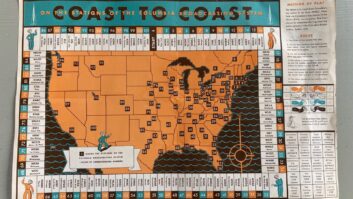Walking the floor of the CES Show (which drew 170,000 attendees and 3,800 exhibitors this year) can be a blast for any broadcast tech person.
Radio World caught up with Rich Redmond, chief product officer for manufacturer GatesAir, to gather his impressions after he strolled the aisles at the Vegas show last week.
RW: How was the show?
Redmond: This year’s CES Show continued to show the evolution of technology with more trends including IP technology for the delivery of rich media content.

Solid displays of HD Radio technology for the audio; this has become more of a given rather than unique. It seems there were many automakers showing HD Radio (right) and the associated features in their vehicles.
It was hard to escape video even in the audio areas, with rich graphical interfaces that included album art for example, but it was clear that almost all consumer devices had a key focus on video.
RW: What notable trends did you spot that Radio World readers should know about?
Redmond: HD Radio is here to stay, and seems to have wide adoption by auto makers. The use of multiple platforms to delivery audio and video content is the norm, most devices had multiple ways to receive content; broadcasters need to continue to think of themselves as providing content over multiple platforms, broadcast OTA, streaming, mobile devices, virtually all connected devices in both real time, and non-real-time delivery.
Drones are everywhere. There was much discussion I had with other radio broadcasters about the applicability in their operations. Applications ranged from using them to capture video at station events for use on the web and other delivery platforms like I mentioned. Other applications were more technical, such as using them to do tower inspections, or potentially a low cost way to “fly” the station antenna pattern in the field. In any case this was a key trend in technology, with many available at low cost (a few hundred dollars) and most including an HD camera with a wireless link to the ground.
RW: Any specific products or booths that really caught your attention?
Redmond: 4K TVs were everywhere and elevate the expectations of great-looking video, at more and more affordable prices. Over-the-air next generation ATSC 3.0 showed not only great-looking video but a wealth of additional services that broadcasts can monetize including hyper local.
LG showed a flexible “rollable” video display that one could imagine being located in a variety of places in a broadcast facility.

While an alarm clock that wakes you up with music in old news, one from Sensorwake that wakes you up to smells of your choice was interesting (right). It uses a replaceable cartridge to provide your morning aroma.
RW: How are “connected car” developments changing our business?
Redmond: Certainly the connected car provides additional access to other content providers beyond the traditional broadcasters. I believe that broadcasters have the best local content that most mobile consumers are looking for, and can enhance their delivery using the connectivity in the car to augment their current delivery methods. This is similar to the work that is being done with Radio DNS and I believe some of the content delivery platforms like iHeartRadio; in this case the IP connectivity to the car is the link that can delivery additional content.
However it is all about the content, and the delivery method is not what consumers really focus on. The key for radio is to not be afraid of new delivery methods, but to make their content available on these platforms to reach consumers who opt for those methods of delivery.
RW: Anything else we should know?
Redmond: Retro is big; from some of the booths you might have thought you were at a 1970s CES convention (below). Retro component stereos and turntables were everywhere; when you looked closely you saw they included up-to-date features like Bluetooth connectivity (below right). Anyone with a large collection of records now can have a number of new products to listen to cue burn on, and explain to anyone under 40 what causes that noise at the beginning of the song.












